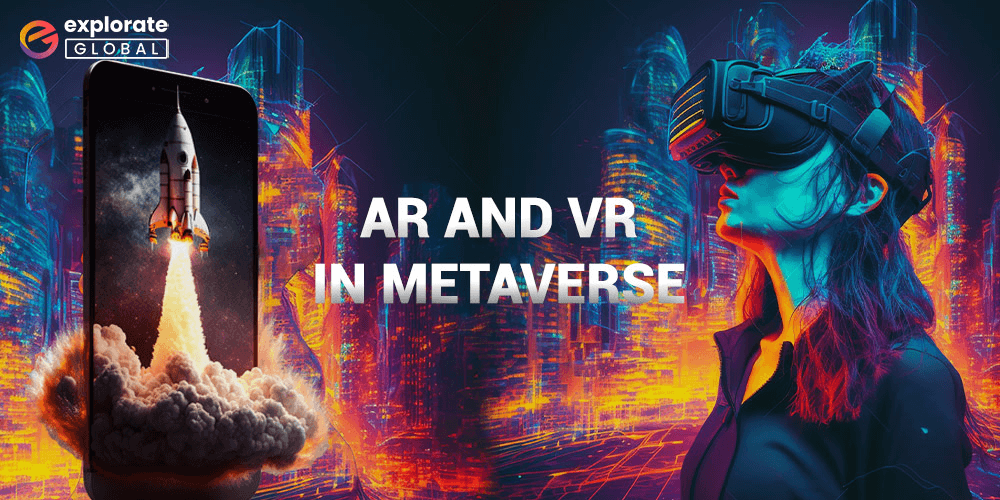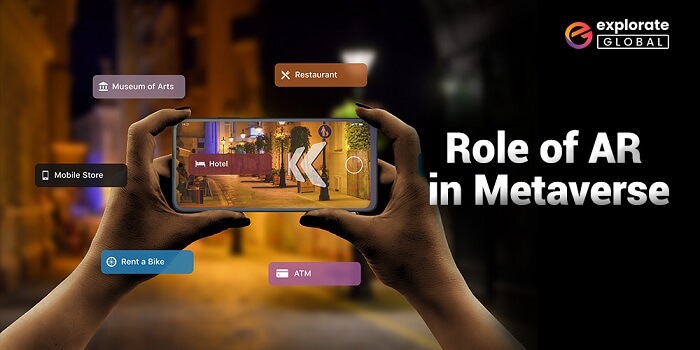
The term “Metaverse” is not just a word, concept, or trend, many tech companies around the globe believe it to be the future of the internet!
The Metaverse is at the top of the list of cutting-edge technological ideas to appear in the last few years. Metaverse is still in the early stages of development. Hence, it is hard to foresee the extent to which it will change the way we exist in the world.
However, we can undoubtedly examine the key technologies that will build the Metaverse. The concept of the Metaverse is much broader and is a combination of various modern technologies.
This covers a wide range of technologies, such as Augmented Reality (AR), Virtual Reality (VR), Blockchain, the Internet of Things (IoT), Web3, and many others. The top two technologies on this list are Augmented Reality and Virtual Reality.
Here, in this write-up, we are going to discuss the role of AR and VR in the Metaverse in detail to understand why they are necessary for the Metaverse. But, first, let us clear the concept of Metaverse in brief for our novice readers. Continue Reading!
Introduction to Metaverse
Since the word “Metaverse” first gained popularity on the Internet, there has been a constant discussion about what it really refers to and how it varies from what we currently experience.
In a nutshell, the Metaverse is a virtual space where people can interact with one another using a wide range of technologies. To accomplish this, a combination of hardware and software is used.
Each company’s interpretation regarding the concept of Metaverse is different. However, they all picture it as a network of 3D environments that are created in real-time. Also, a lot of individuals can access it at once. You can work, study, chat, chill, attend virtual concerts, and engage in other activities in the Metaverse.
It is meant to be a replica of the real world. But in its marketed version, the Metaverse continues to be true to itself. Facebook claims that the Metaverse will bring together both the digital and real worlds, enabling peer-to-peer, lifelike engagement in virtual workplaces.
Collaborations would simulate real-world scenarios where AR and VR elements will merge to give users an experience outside the realm of the laws of physics. Any action, such as traveling, enjoyment, working, and running, is theoretically possible on the Metaverse.
Now, let us understand more about the technologies and the role of AR and VR in the Metaverse below to get a better understanding of the development of the Metaverse.
What are AR and VR?
AR and VR are the main building components of Metaverse projects. Three fundamental components—coupling the virtual and real worlds, real-time contact, and precise 3D object visualization—underlie how Augmented reality systems work.
Since AR apps are easy to download and use on any camera-enabled gadget, they have a higher usage rate than VR apps. AR enriches objects with immersive aspects that increase the informational aspect. Ad-hoc devices are not necessary for users in order to take advantage of Augmented reality.
On the contrary, Virtual reality (VR) is a completely simulated interaction in a digital, artificial environment. The role of VR in Metaverse is to provide sensory experiences that are on par with the user’s physical world.
VR systems cost a little more than AR systems because they require extra hardware like a multimodal projection screen(s) or head-mounted display.
In Metaverse VR applications, we can experience Extended Reality (XR), a combination of the role of AR and VR in the Metaverse.
Read further in this article to get an in-depth understanding of the role of AR and VR in the development of Metaverse.
Role of AR in Metaverse
AR, or Augmented Reality, is one of the Extended Reality technologies. It is currently extremely popular and growing rapidly. With the help of digital sensory data like graphics and video, etc., Augmented reality gives users a live perspective of the physical world.

Users of Augmented reality (AR) applications can see the real world and change it virtually using their smart glasses and smartphones.
The idea behind Metaverse Augmented reality is to merge both the digital and physical worlds in one place. On a commercial scale, Augmented reality is already extremely useful in a variety of fields, including marketing, education, and health.
The Metaverse may also benefit greatly from AR in establishing its commercial presence. Aside from stabilizing its comprehensive experience, the role of AR in Metaverse has many special applications. AR serves as a link between the real world and the meta world.
Role of VR in Metaverse
Since the concept of the Metaverse significance is so vibrant, it is impossible to accomplish the goals without utilizing a wide variety of additional resources. The Metaverse guarantees to deliver a dynamic, completely immersive 3D environment. Hence, to accomplish that, it will require VR technologies that can guarantee true telepresence.

But, what is VR in Metaverse? Here’s the take – In simple terms, Virtual Reality (VR) creates a blurred line between the real-world experience and the virtual-world experience.
It will be possible to significantly change how people go to work and school, attend concerts, shop, and enjoy games by connecting VR and the Metaverse. Metaverse VR headsets are probably used for a variety of activities that are usually carried out with smartphones. Such as making purchases or working with coworkers.
You will need a virtual reality headset to interact in a virtual environment. It serves as one of the main requirements for accessing the Metaverse. A Metaverse becomes an important part of the virtual ecosystem when people use virtual reality headsets to work and communicate within it.
Hence, the role of VR in Metaverse is to improve the fundamental framework of Metaverse technology.
Now that we have understood the role of AR and VR in the Metaverse in detail, let us look at the future of the Metaverse in the below section.
Future of Metaverse
Now we know what is the exact role of AR and VR in the development of Metaverse and how to use AR/VR in Metaverse. Let us examine the technology’s future.

Although the idea of the Metaverse seems fascinating, it is hard to foresee what it might look like in the future. The development of 5G and the growing opportunities for VR and AR in Metaverse may actually contribute to creating the ideal environment for something like this.
However, the creators of the Metaverse will face numerous challenges. One of them is the interoperability of digital items, which is essential to the Metaverse’s growth. Another requirement of the Metaverse is real-time data synchronization, which can be expensive and challenging to do at scale. However, given how extensive the role of AR and VR in the Metaverse seems, the future of this industry looks bright.
Businesses that want to create virtual reality features or Augmented reality apps have a great chance of meeting the market’s growing demand. By 2026, the study predicts that the global VR market will have grown to $184.66 billion.
VR/AR technologies are crucial for the development of Metaverse. Hence, the industry is expected to grow quickly in the coming years. In a nutshell, if the Metaverse is a virtual environment, VR is a way to reach it.
The Role of AR and VR in the Metaverse – FAQs
Q.1) Do users really need VR for Metaverse?
The majority of Metaverse platforms let users engage with or without VR. Metaverse is a new and developing market. Hence, users don’t need to spend money on expensive VR hardware to experience the Metaverse. You may access the Metaverse using any computer or device that supports the web.
Q.2) Why Metaverse is Important in 2023?
The Metaverse is expected to grow rapidly in 2023. It will accelerate its expansion and enhance its immersion. The avatars that reflect you in the Metaverse are likely to become more realistic as technology develops, enabling more complicated interactions in virtual environments.
Q.3) Do we need VR and AR for Metaverse?
No, VR is not mandatory for Metaverse platforms. But, an active role of AR and VR in the Metaverse can increase the Virtual world experience of users. As a result, it is true to say that the Metaverse depends on both VR and AR.
Also know: Fix Oculus Quest 2 Mic Not Working Issue
Closing Lines: Role of AR and VR in the Development of Metaverse in 2023
To sum up, the Metaverse is a fascinating and quickly developing technology with a number of upcoming trends worth looking forward to in 2023. Thanks to the development of NFTs, social VR, and the role of AR and VR in the Metaverse, our ability to communicate, learn, and make purchases is about to undergo a fundamental shift. The Metaverse will undoubtedly play a bigger part in our everyday lives!
However, if you wish to add something more about Metaverse or wish to give us feedback on this blog post, feel free to drop them in the comments section below.


